


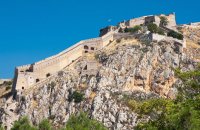
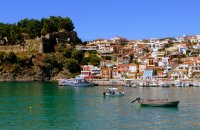
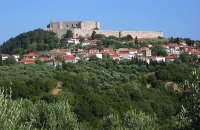
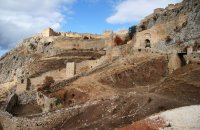
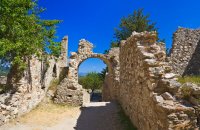
Inasmuch as there may exist such a phenomenon as “castle tourism,” i.e. traveling to and from in order to see, or maybe even to stay in a castle, then surely Greece ought to be an ideal place for its development. For all about the country are scattered hundreds of castles, keeps, and towers from all periods. Some are still inhabited today. Some are well preserved, while others have been reduced to heaps of gigantic hewn stones. We will turn our attention to ten castles that are in such a shape that the traveler with a bit of imagination ought to be able to conjure a mental image of their former glory.
In the number ten position are the castle cities of Chios. These villages, known for their production of mastic gum, are so built as to afford them the protection of the castle. They present an alternative architectural perspective, and yes, they are still inhabited.
Rising above the tranquility of the Aegean, the castle at Astypalia claims spot number nine. A large portion of it has been destroyed, but nevertheless it is so scenic that it deserves a place in our Top Ten list.
At number eight, we have Castle Chlemoutsi, since it is in an excellent state of preservation and offers a stunning sunset.
At number seven is the castle of Parga. Small, but lovely. Nowadays the permanent residents of this castle are the trees that have grown up within its walls. The view from atop Parga and the little islet is splendid, and the coffee/refreshment shop takes care of the hospitality angle for the castle.
Sixth place rightfully belongs to the Castle at Ioannina, thanks not only to the many brave youths who lost their lives there, but also because as it rises above and around the calm waters of the lake, it remains and will continue to remain the trademark of the city. It is a member of the category of inhabited castles, since encircled inside its well-preserved walls are homes and sights from the Ottoman period.
In fifth place is the renowned castle at Nafplion, where one must ascend nine hundred and ninety nine steps to reach its tower; but nobody protests while they do.
The battered castle of Mystra claims fourth place. The greater part of it does not survive, but it dates from the period of the Paleologues, (Byzantine era) and thus as you encounter it amongst the verdant foothills, far away from civilization, it spontaneously provokes a sense of wonder.
In third place is Acrocorinthos. Visible from miles away, its walls crown the peak of the giant rock, really a small mountain to be more precise, and seem as though inhabited even today. Acrocorinthos has endured the millennia, bringing to us images of the urban life of earlier times.
Not only the castle, but really an entire settlement of the middle ages, awaits those who visit Rhodes. Justly it deserves second place, for it literally resembles the set of a period movie.
And at Number One, the castle of Monemvasia, for its uniqueness. The perfect synergy between man and nature, built atop a cliff a thousand feet above the waves, a castle-city that despite sieges and wars remains inhabited to this day. To be sure, not only is it inhabited, but it is one of the most romantic vacation destinations in all of Greece.
This Top Ten list represents just a few of the literally hundreds of castles that merit a visit while in Greece. It omits, for example, impressive castles such at those of Platamona, Nafpaktos, Plevrona, and many more. It seems that many castles in each district could be preserved, but are left to fall to the onslaught of unmerciful years. Couldn’t they perhaps better be developed to become hotels, restaurants, and museums, thus preserving something of the history recounted by their walls? Even as they are, a visit to a castle is accompanied by a web of mystery, inciting the imagination to immeasurable speculation about how life must have been, what color the streets might have been, which heroes defended them during difficult times, for what celebrations were opening their gates…











